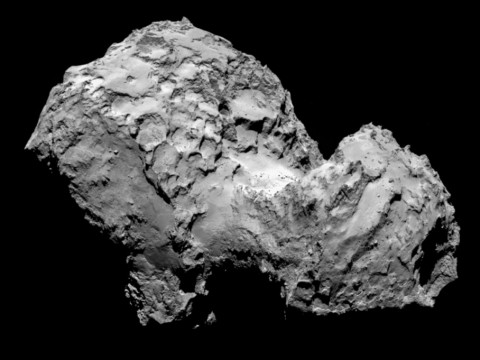
A view of Comet 67P/Churyumov-Gerasimenko taken by Rosetta’s OSIRIS narrow-angle camera on Aug. 3 from a distance of 177 miles. (European Space Agency image.)
The European Space Agency’s Rosetta spacecraft achieved orbit around Comet 67P/Churyumov-Gerasimenko on August 6. Ten years on the way, traveling four billion miles and aided by four gravity assists (three from Earth and one from Mars), Rosetta will escort the comet as it swings around the Sun and heads back toward Jupiter.
Rosetta will study the comet an OSIRIS camera, a MIRO miniature radio telescope, an Alice ultraviolet (UV) spectrograph, an Ion and Electron Sensor (IES) and other instruments.
Rosetta also carries a lander, Philae, that will be dropped on the comet’s surface in November 2014, where it will drill, extract and analyze samples, and send pictures back to Earth.
Based on temperature readings made by Rosetta’s instruments, scientists already have surmised that the comet has a porous, dusty crust with ice beneath. The surface is strewn with boulders the size of houses, and Churyumenko-Gerasimov’s icy cliffs rise as high as 500 feet (150 meters).
Rosetta initially will orbit about 60 miles from the comet, but eventually will move in closer, about 12 to 20 miles away.
Update 08/07/2014: Corrected misspelling of “ultraviolent” spectrograph.
Discover more from File 770
Subscribe to get the latest posts sent to your email.


I’m just glad it’s nowhere near us in its orbit. What that thing could do slamming into the Earth is something only a Discovery Channel program could bear.
And speaking of the Discovery and History channels:
http://basicinstructions.net/basic-instructions/2012/2/28/how-to-face-the-end-of-civilization-again.html
“an Alice ultraviolent (UV) spectrograph”. Was this made by the Umbrella Corporation by any chance?
Brilliant headline.
(Though I’m hoping that the Alice spectrometer is not actually ultraviolent.)
There’s a Freudian slip if ever there was one.